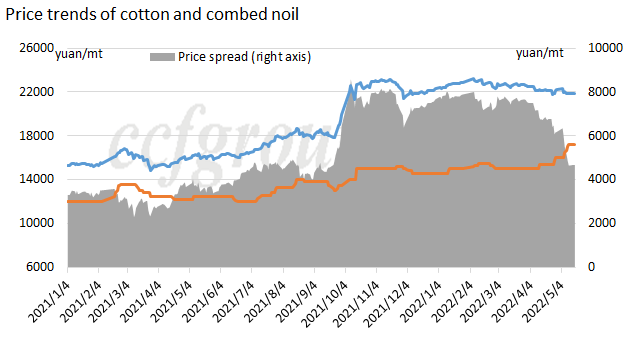Demand recovery seen from the rise of open-end cotton yarn?
Overall trade on cotton yarn market has improved since May Day holiday, especially open-end cotton yarn, which has seen rise of price and surge of sales ratio but ring-spun one remains plain. Why does open-end cotton yarn stand out?
1. Raw materials prices spike amid reduced supply of combed noil.
Open-end cotton yarn price has moved up by 500yuan/mt since early May, and many mills intend to adjust up prices further. It mainly lies in the sudden rise of raw materials price. From the chart, it shows that cotton price rocketed from last Oct, but combed noil only increased slightly at that time, so their spread widened quickly and then stayed high. After May Day holiday in 2022, combed noil jumped from just over 15,000yuan/mt to over 17,000yuan/mt with an increase of narly 1500yuan/mt. The sharp rise of combed noil is mainly contributed by less supply. So far, many cotton yarn mills are still in production cut or suspension, and some combed cotton yarn mills shift to produce carded one due to poor sales. On the other hand, it is heard that a combed noil warehouse in Xinjiang caught a fire during Labor’s Day holiday, and over 10kt of combed noil stocks were damaged. That is to say overall supply reduction pushes the surge of price. Currently the price spread of cotton and combed noil has fallen back to normal level.

2. Demand spurs the price.
The demand for open-end cotton yarn actually turns better. Firstly, downstream orders increase. The first half year is indeed the peak season for open-end cotton yarn in terms of seasonal demand. Secondly, under much higher price of forward imported cotton yarn, cotton yarn imports declined and traders and downstream plants turned to operate or use Chinese open-end cotton yarn for instead. Thirdly, downgrade of products. At present, cotton price remains high and downstream plants could only obtain thin profit, or even suffer losses. They have to lower cost and use cheaper open-end cotton yarn. The most replacement is seen between open-end cotton yarn and Pakistani siro-spun one for denim, and between open-end 21-32S and ring-spun 21-32S. Fourthly, downstream buyers stock up facing the surge of raw materials.
In conclusion, both cost and demand make contribution to the spike of open-end cotton yarn. However, the increase in cotton yarn is far behind that in combed noil, to the effect that although the price of open-end cotton yarn improves, cotton yarn mills bear worse losses and the support from demand is not enough.
At last, the demand for open-end cotton yarn and ring-spun one is expected to turn better later when the lockdown in Shanghai is lifted and the pandemic in China tends stable, especially export demand.
- Top keywords
- Cotton Price
- Cotton Futures Price
- Cotton Futures
- CZCE
- PTA Futures Price
- Chemical Fiber
- Polyester Prices
- Wool price
- PTA Futures
- Shengze Silk
- China
- Yarn Price
- price
- China Textile City
- Fibre Price
- Benzene Price
- Cotton
- Index
- Cotton Index
- PTA
- fabric price
- NYMEX
- Top 10
- textile industry
- Spot Cotton
- Cotton Yarn
- Polyester Price
- Futures
- PTA Price
- cotton yarn price

